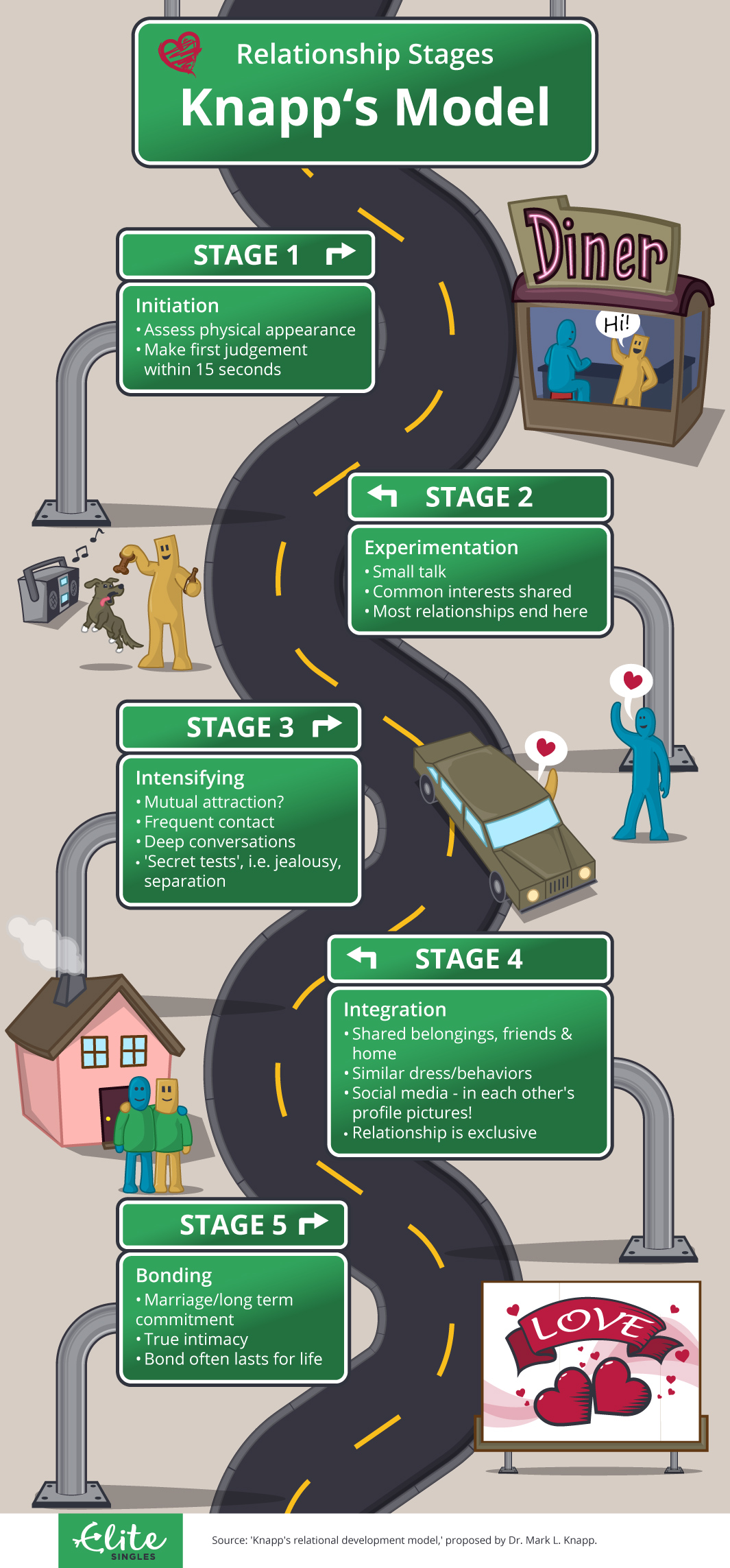Struggling to tell whether you're in love or lust? Find out how to identify the key differences between the two now!
If you’ve ever cranked up the old internet machine and hammered ‘stages of a relationship’ into Google, you’ll have realised that for the most part, no two articles seem to be able to agree on what the stages actually are, or how many even exist. Well, we’re aiming for the sky at EliteSingles, so we’ve swan dived into the world of academia and sought out a duo of experts who have worked to develop one of the most respected theories on the different stages of a relationship.
Knapp’s Relational Development Model is a well documented theory on the stages of a relationship, and is the brainchild of communication scholar Mark L. Knapp. In the model, Knapp divided the average couple’s journey into two phases containing five stages. The two phases are ‘Coming Together’ and the slightly less enjoyable ‘Coming Apart’, and together they chart the trajectory of relationships from start to (possible) finish. The stages are as follows:
Stages of a Relationship – Knapp’s Relational Development Model
The ‘Coming Together’ Phase
Initiation – First impressions are made in less than 15 seconds. This is when we display our best selves. We observe the other person intensely, in order to learn about them. Physical appearance plays a big role.
Experimentation – This is a period of increased self disclosure, where we begin learning about each other. Small talk leads to finding things in common. Most relationships in life won’t progress past this stage – think of ‘water cooler’ office relationships.
Intensifying – We determine whether there is mutual affection/attachment through deeper conversations and frequent one on one contact. In this stage, we undergo ‘secret tests’ to see if the relationship will flourish. These can include going public as a couple, being apart for an extended period, jealousy, friend’s opinions, and either partner going through a tough time outside of the relationship. Of course, this period can be disruptive.
Integration – Belongings/friends/home are shared, and similar dress/behaviors are adopted. In today’s world, social media may play a role, for example a couple may feature in each other’s profile pictures. The couple is exclusive to one another, and each partner’s secrets, sexual behaviors and future plans are revealed.
Bonding – This usually occurs in the form of marriage or another method of showing the world you’re a team and your relationship is truly intimate. Once this stage is reached, many couples stay bonded for good.
The ‘Coming Apart’ Phase
Differentiating – The couple becomes disengaged. Differences are emphasized, and similarities wear down, leading to conflict. This can be the result of bonding too quickly. However this is an expected stage of any relationship, and can be solved by giving each other space.
Circumscribing – This is a breakdown of communication, during which expressions of love decrease.
Stagnation – One or both parties feel trapped. Issues aren’t raised because partners know how the other will respond already. It is still possible for the relationship to be revived – but many simply stay together to avoid the pain of ending a relationship.
Avoidance – Partners ignore each other and avoid frequent contact, leading to a less personal relationship and gradual emotional detachment.
Termination– One or both partners are unsatisfied, unhappy, and the relationship must end. Reasons for this can be physical separation, or simply growing apart as time passes.

So then, at first glance, Knapp’s theory on the stages of relationships seems to explain the usual patterns couples go through when pairing up – think of the blissful ‘honeymoon’ period and the enormous and powerful emotions that are bandied about as we fall in love.
In order to further crack open the theory and have a good old rummage inside, EliteSingles contacted two co-authors of the original book containing the stages. Dr. Anita Vangelisti is a professor at the University of Texas specializing in interpersonal communication, and Dr. John Caughlin is a professor of interpersonal communication in close relationships at the University of Illinois. Together, they shed some light on one of the most famous models of the stages of relationships.
In Knapp’s Model, at which stage does a relationship turn from platonic to romantic, or can this occur at any point in the progression?
Vangelisti: We would expect a transition from platonic to romantic would be most likely during the intensifying or integrating stages, but it could happen during any stage. For example, two people could meet (initiate a friendship) and, once they move to the experimenting stage, discover that they are interested in more than a friendship.
Is every stage of Knapp’s model inevitable, or can relationships ever skip any of these stages?
Caughlin: The model’s sequence occurs for a variety of reasons, including the fact that “each stage contains important presuppositions for the following stage”. But people can skip stages or take them out of order. For example, I have heard stories of people who quickly go through initiating and experimenting and then head right for the altar – think Las Vegas weddings.
As the model suggests, skipping those steps is a “gamble on the uncertainties presented by the lack of information that could have been learned in the skipped step”. That does not mean that the relationship will inevitably break apart, but it is a risky move.
Can stages recur indefinitely?
Vangelisti: Yes, stages can recur over and over again. It is important to know, though, that each time couples go back and “repeat” a stage, their experience will be different than it was before. They will bring old experiences, a set of memories, and new ideas with them when they go through that stage again.
Caughlin: Changing one’s Facebook status back to “in a relationship” says something different about the couple than does changing it to “in a relationship” the first time.
Do you feel it’s beneficial for couples seeking a happy relationship to be aware of the model?
Caughlin: It can be helpful for a number of reasons. For example, it can help make sense of why one’s partner is engaging in certain behaviors, which can be useful in helping to understand the meaning of those behaviors.
Vangelisti: However, it’s important to note that partners can over-analyze their relationship. Sometimes one partner says something nasty to another because they had a bad day – and the nasty comment doesn’t indicate anything negative about the relationship. It’s important to remember that patterns of behavior tend to be more meaningful than individual behaviors.
At which stage of the ‘coming together’ phase, if any, do most romantic relationships tend to struggle or end?
Caughlin: I do not think it is accurate to say that “most” romantic relationships struggle at any particular point. However, research on “relational turbulence” has shown that a lot of couples experience a turbulent period when they are deciding whether to move from casually dating to a more committed relationship. This can be an intense time in a relationship with lots of emotion (both positive and negative), and it is a time when some couples will decide not to continue and others settle down. This period of turbulence roughly corresponds to the transition between intensifying and integrating.
Vangelisti: But I think it’s important to note that individual partners may struggle at different stages for different reasons. So, for example, a person who is very, very shy might struggle with the initiating stage, but be fine once he or she gets to the intensifying stage. Generally people who have high self-esteem and positive, trusting relationship experiences are going to struggle less than those with low self-esteem and more negative, unpredictable relationship experiences.
Since its inception, has the nature of how romantic relationships are formed changed?
Vangelisti: The way relationships are formed certainly has changed over time. The example that probably comes to mind for most people is the increased frequency with which partners initiate relationships online rather than face-to-face. In this case, while the channel that individuals are using to initiate their relationships has changed, the behaviors they engage in have not changed all that much.
People still take time to “get to know” each other – and research shows that the majority of relationships initiated online move offline fairly quickly if they are going to progress.
Is a ‘happily ever after’ possible in Knapp’s model?
Vangelisti: People often think ‘’happily ever after’ means that the happy couple never disagree, never annoy each other, and never have doubts about their relationship. Knapp’s model suggests that even happy couples experience ups and downs in their relationships. What matters is how they handle those ups and downs. The ability – and the willingness – to get through the down times together is what makes relationships work.
Caughlin: If that is asking whether a couple can be in the bonding stages for a long time and have both partners report being happy, then sure, that happens. But happily ever after does not happen if one means that in the sense of the Hollywood love story where the end of the movie is the wedding and the couple is assumed to be perpetually blissful.
Realistically, most couples will experience at least some elements of coming apart at different times. Happily ever after is not an achievement but instead requires communication practices that continue to foster happiness.
Vangelisti: Do they work together to get through difficult times? Do they respect each other enough to listen to each other – even when they disagree? Are they willing to overlook annoyances because they know that their partner’s positive qualities outweigh his or her annoying habits? Are they able to talk about their doubts and resolve them together? The ability – and the willingness – to get through the down times together is what makes relationships work.
*****
So there you have it, folks. A brief glimpse into the theory behind the various stages of a relationship tells us that a successful and happy relationship that lasts a lifetime is completely possible as long as both parties are willing to dole out a little patience and understanding. And if you’re looking for the perfect partner to begin your life’s journey with? Take your first step by completing the personality test on EliteSingles!
Direct quotes are passages from ‘Interpersonal Communication & Human Relationships’ (7th ed.) by Knapp, Vangelisti, and Caughlin



